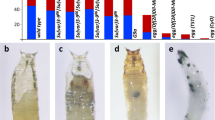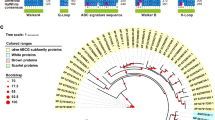Abstract
Drosophila miranda possesses an intriguing sex chromosome constitution. While female metaphase plates have 10 chromosomes (diploid set), in males only 9 chromosomes can be identified. The missing homologue has been translocated to the Y, forming a neo-Y chromosome which is polytenized in the salivary gland cells. This report presents a detailed characterization of DNA, isolated from D. miranda flies. In situ hybridizations, using cRNA transcribed from unfractionated D. miranda DNA, reveal hybridization to the neo-Y with label distributed over the entire chromosome. The original partner of the translocated chromosome, X2, is essentially unlabelled. These results suggest that repetitive DNA sequences “invade” the translocated chromosome. This result is discussed with reference to the hypothesis of “degeneration” of the Y chromosome, formulated by Muller (1918, 1932a).
Similar content being viewed by others
References
Atherton, D., Gall, J.G.: Salivary gland squashes for in situ nucleic acid hybridization studies. Dros. Inf. Serv. 49, 131–133 (1972)
Barnett, T., Rae, P.M.M.: A 9.6 kb intervening sequence in D. virilis rDNA and sequence homology in rDNA interruptions of diverse species of Drosophila and other diptera. Cell 16, 763–775 (1979)
Brown, D.D., Wensink, P.C., Jordan, E.: Purification and some characteristics of 5S DNA from Xenopus laevis. Proc. Natl. Acad. Sci. (Wash.) 68, 3175–3179 (1971)
Cairns, J.: The chromosome of Escherichia coli. Cold Spr. Harb. Symp. quant. Biol. 28, 43–46 (1963)
Corneo, G., Ginelli, E., Soave, C., Bernardi, G.: Isolation and characterization of mouse and guinea pig satellite deoxyribonucleic acids. Biochemistry 7, 4373–4379 (1968)
Dobzhansky, Th.: Drosophila miranda, a new species. Genetics 20, 377–391 (1935)
Gehring, W.J., Paro, R.: Isolation of a hybrid plasmid with homologous sequences to a transposing element of Drosophila melanogaster. Cell 19, 897–904 (1980)
Green, M.M.: Transposable elements in Drosophila and other diptera. Ann. Rev. Genet., 14, 109–120 (1980)
Hennig, W.: Highly repetitive DNA sequences in the genome of Drosophila hydei. J. molec. Biol. 71, 407–417 (1972)
Jensen, R.H., Davidson, N.: Spectrophotometric, potentiometric, and density gradient ultracentrifugation studies of the binding of silver ion by DNA. Biopolymers 4, 17–32 (1966)
MacKnight, R.H.: The sex-determining mechanism of Drosophila miranda. Genetics 24, 180–201 (1939)
Mandel, M., Marmur, J.: Use of ultraviolet absorbance-temperature profile for determining the guanin plus cytosine content of DNA. In: Methods in enzymology, 12B (L. Grossman, and K. Moldave, eds.), pp. 195–206. New York, London: Academic Press 1968
Muller, H.J.: Genetic variability, twin hybrids and constant hybrids, in a case of balanced lethal factors. Genetics 3, 422–499 (1918)
Muller, H.J.: Some genetic aspects of sex. Amer. Naturalist 66, 118–138 (1932)
Pardue, M.L., Gall, J.G.: Nucleic acid hybridization to the DNA of cytological preparations. In: Methods in cell biology (D.M. Prescott ed.) 10 pp. 1–16. New York, San Francisco, London: Academic Press 1975
Rae, P.M.M.: Chromosomal distribution of rapidly reannealing DNA in Drosophila melanogaster. Proc. Natl. Acad. Sci. (Wash.) 67, 1018–1025 (1970)
Rae, P.M.M., Franke, W.W.: The interphase distribution of satellite DNA-containing heterochromatin in mouse nuclei. Chromosoma (Berl.) 39, 443–456 (1972)
Renkawitz, R.: Isolation of twelve satellite DNAs from Drosophila hydei. Int. J. Biolog. Macromolecules 1, 133–136 (1979)
Rudkin, G.T.: Replication in polytene chromosomes. In: Results and Problems in Cell Differentiation (W. Beermann, ed.) 4, pp. 59–85. New York: Springer 1972
Spradling, A.C., Rubin, G.M.: Drosophila genome organization: Conserved and dynamic aspects. Ann. Rev. Genet. 15, 219–264 (1981)
Steinemann, M.: The in situ formation of DNA·DNA duplexes of Drosophila virilis satellite DNA. Chromosoma (Berl.) 54, 339–348 (1976)
Steinemann, M.: Chromosomal replication in Drosophila virilis. I. Diploid karyotype of brain cells. Chromosoma (Berl.) 78, 211–223 (1980)
Strobel, E., Pelling, C., Arnheim, N.: Incomplete dosage compensation in an evolving Drosophila sex chromosome. Proc. Natl. Acad. Sci. (Wash.) 75, 931–935 (1978)
Studier, F.W.: Sedimentation studies of the size and shape of DNA. J. molec. Biol. 11, 373–390 (1965)
Sueoka, N.: Variation and heterogeneity of base composition of deoxyribonucleic acids: A compilation of old and new data. J. molec. Biol. 3, 31–40 (1961)
Szybalski, W., Mennigmann, H.-D.: The recording thermospectrophotometer, and automatic device for determining the thermal stability of nucleic acids. Anal. Biochem. 3, 267–275 (1962)
Wensink, P.C., Tabata, S., Pachl, C.: The clustered and scrambled arrangement of moderately repetive elements in Drosophila DNA. Cell 18, 1231–1246 (1979)
Wetmur, J.G., Davidson, J.G.: Kinetics of renaturation of DNA. J. molec. Biol. 31, 349–370 (1968)
Author information
Authors and Affiliations
Rights and permissions
About this article
Cite this article
Steinemann, M. Multiple sex chromosomes in Drosophila miranda: A system to study the degeneration of a chromosome. Chromosoma 86, 59–76 (1982). https://doi.org/10.1007/BF00330730
Received:
Issue Date:
DOI: https://doi.org/10.1007/BF00330730




